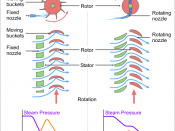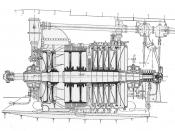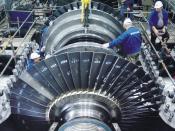Steam Turbines
The invention of the water turbine was so successful that eventually, the idea came about
for extracting power from steam. Steam has one great advantage over water-it expands in
volume with tremendous velocity. To be the most effective, a steam turbine must run at a very
high speed. No wheel made can revolve at any speed approaching the velocity that a steam
turbine can. By utilizing the kinetic energy of steam flow, the turbine could achieve a higher
efficiency. As a result, the steam turbine has supplanted the reciprocating engine as a prime
mover in large electricity-generating plants and is also used as a means of jet propulsion.
The action of the steam turbine is based on the thermodynamic principle that when a vapor
is allowed to expand, its temperature drops. In turn, its internal energy is decreased. This
reduction in internal energy is transformed into mechanical energy in the form of an acceleration
of the particles of vapor.
The transformation that occurs, provides a large amount of available
work energy.
The essential parts of all steam turbines consist of nozzles or jets through which the steam
can flow and expand. Thus, the temperature drops, and kinetic energy is gained. In addition,
there are blades, on which high pressure steam is exerted. Stationary blades shift the steam onto
rotating blades, which provide power. Also, turbines are equipped with wheels or drums where
the blades are mounted. A shaft for these wheels or drums is also a basic component, as well as
an outer casing that confines the steam to the area of the turbine proper. In order to efficiently
use this contraption, it is necessary to have a number of stages. In each of these stages, a small
amount of thermal energy is converted to kinetic energy. If...


